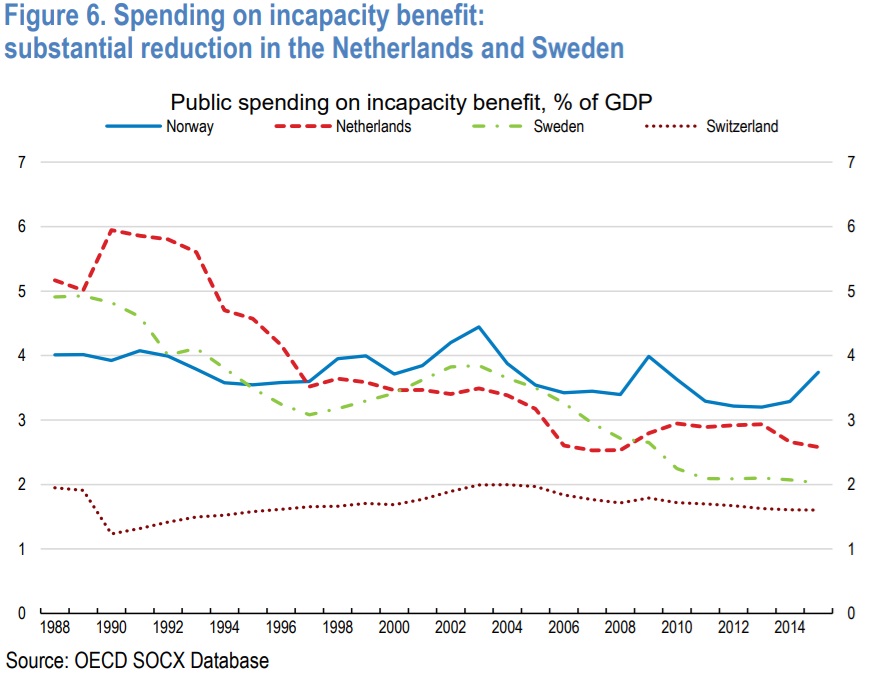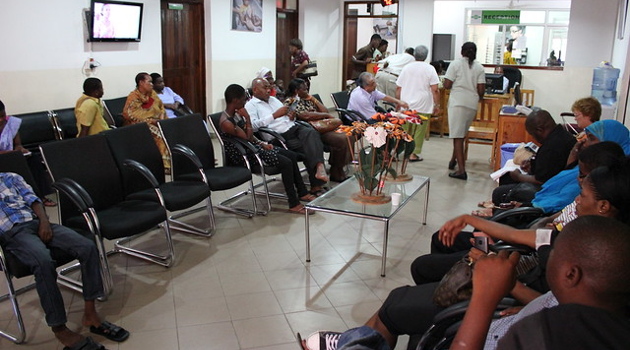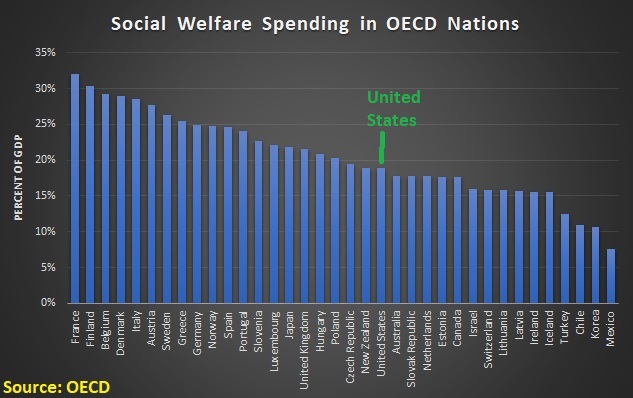Back in 2019, I compared OECD nations based on the total burden of social welfare spending as a share of economic output.
France was the worst of the worst, unsurprisingly, followed by Finland and Belgium.
That column also differentiated by types of spending.
- Greece had the biggest burden of pension spending.
- France had the biggest burden of health spending.
- Belgium had the biggest burden of redistribution spending.
Today, let’s look at an even narrower slice of the social welfare state.
According to a new article in the Economist, Germany arguably has the most lavish sickness benefits in Europe. Maybe the most extravagant in the world.
That sounds very kind and compassionate, but it seems this policy is creating perverse incentives and undermining national prosperity.
Here are some excerpts from the article.
Germany is now “the world champion when it comes to sick days,” according to Oliver Bäte, the boss of Allianz, Europe’s biggest insurer. …Ola Källenius, the boss of Mercedes, agrees with Mr Bäte. He warns of the “economic consequences” of a sickness rate in Germany that is often twice as high as in other European countries. …Germany has one of the most generous sick-leave regimes in the world and it is costing businesses dearly. …“It’s very hard to police,” says Jochen Pimpertz of the German Economic Institute (iw). In a study he found that the total nominal cost of sick pay for employers rose from €36.9bn to €76.7bn between 2010 and 2023 (a 57% increase, adjusted for inflation). …There is clear correlation between the generosity of the system and the number of sick days, says Nicolas Ziebarth of the Leibniz Centre for European Economic Research. Germany’s arrangements are lavish compared with elsewhere in Europe and have become easier to manipulate.
The article mentions that there used to be similar problems in some Scandinavian nations, and that reminded me that Sweden enacted some good reforms a few decades ago.
So I did a search for “sick days Sweden” and found a study published by the OECD in 2020.
Authored by Philip Hemmings and Christopher Prinz, it included this chart showing that spending on sick days was dramatically reduced over a 20-year period, dropping from 5 percent of GDP in the late 1980s to 2 percent of GDP about 20 years later.

How did Sweden get these remarkable results?
The answer was simple. They reduced, in two stages, the amount of money people got for being sick (or, in many cases, for pretending to be sick). Here are a few excerpts from the study.
Sick-leave compensation reform (1990s). Pushed by a major economic downturn in the early 1990s, Sweden embarked on a series of sickness benefit reforms as part of a broader attempt to curb public spending. This included the introduction of a 14-day sick-pay period covered by employers (1992). In addition there were significant changes to compensation: Before 1991, sickness benefits replaced 100% of earnings for 90 days and 95% thereafter, with no time limit. As of 1993, there was no payment on the first day of sickness absence (i.e. one “waiting day”), compensation then varied over time: 75% of previous earnings (days 2 and 3 of absence), 90% (until day 90), 80% (to the end of first year) and 70% thereafter. This reform promoted a sharp drop in absence spells, especially in short-term absences… When the economy recovered in the late 1990s, sick-pay rates were increased, to 90% of the previous wage until the end of the first year and 80% thereafter. This led to a significant rise in absence rates, especially longer-term absences… Overall, the cost of being absent significantly affected absence behaviour. …Starting in 2006, Sweden undertook a series of reforms to sickness and disability policies, which contributed to further considerable drops in both sickness absence rates and disability claims. These reforms included (Economic Survey of Sweden, OECD 2012b) among other things the introduction of…more rigorous implementation of existing regulations… Requirements for individuals on sick leave to consider a wider scope of jobs… A 2.5-year ceiling on the duration of sick leave compensation… More stringent disability-pension entitlement criteria.
The broader lesson from Sweden’s successful reforms is that Ronald Reagan was right.
As was Thomas Sowell.
The more you subsidize of something, the more you get of it.
And, at the risk of stating the obvious, it’s not a good idea to subsidize dependency and idleness.
P.S. Sweden has implemented a lot of good reforms in recent decades. What happened with sickness benefits is laudable, but I’m even more impressed by the country’s partially private Social Security system and the impressive 1992-2001 period of spending restraint. Though a lot more needs to be done.
———
Image credit: Department of Foreign Affairs and Trade | CC BY 2.0.





